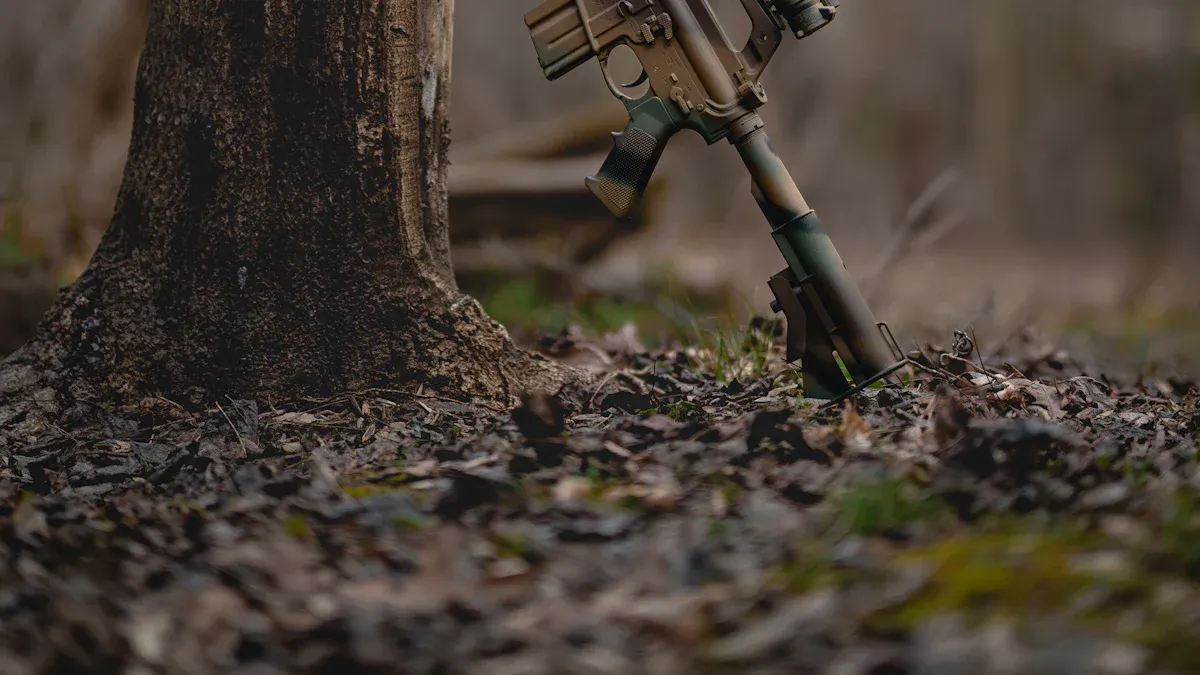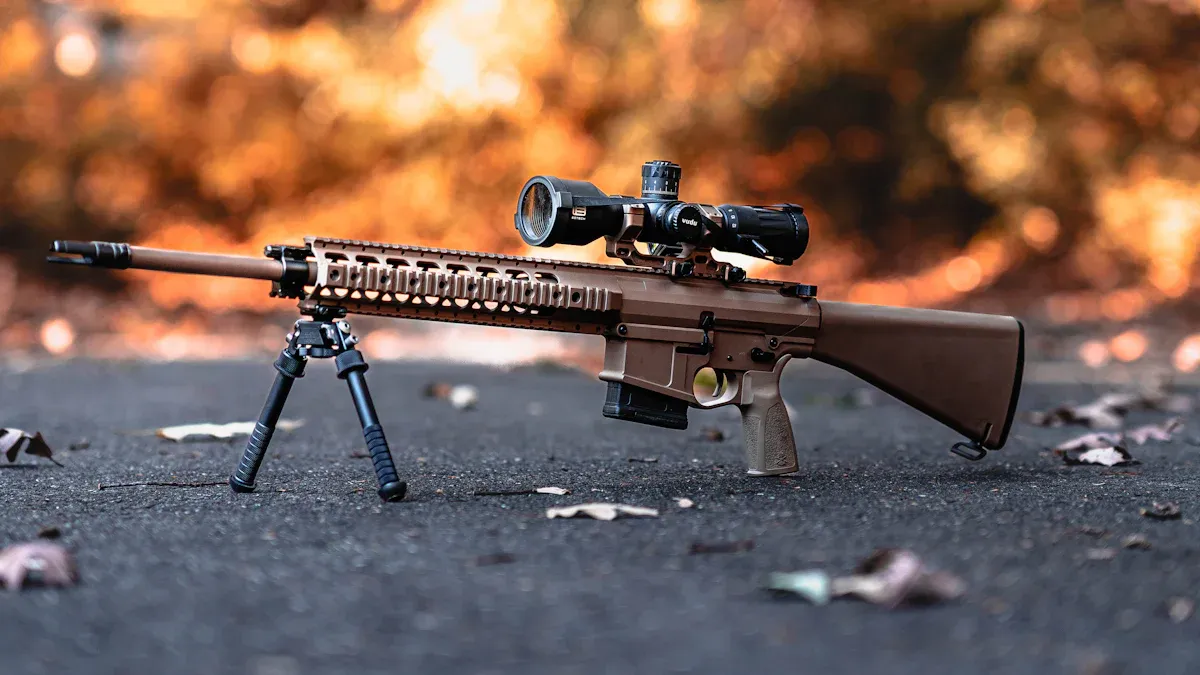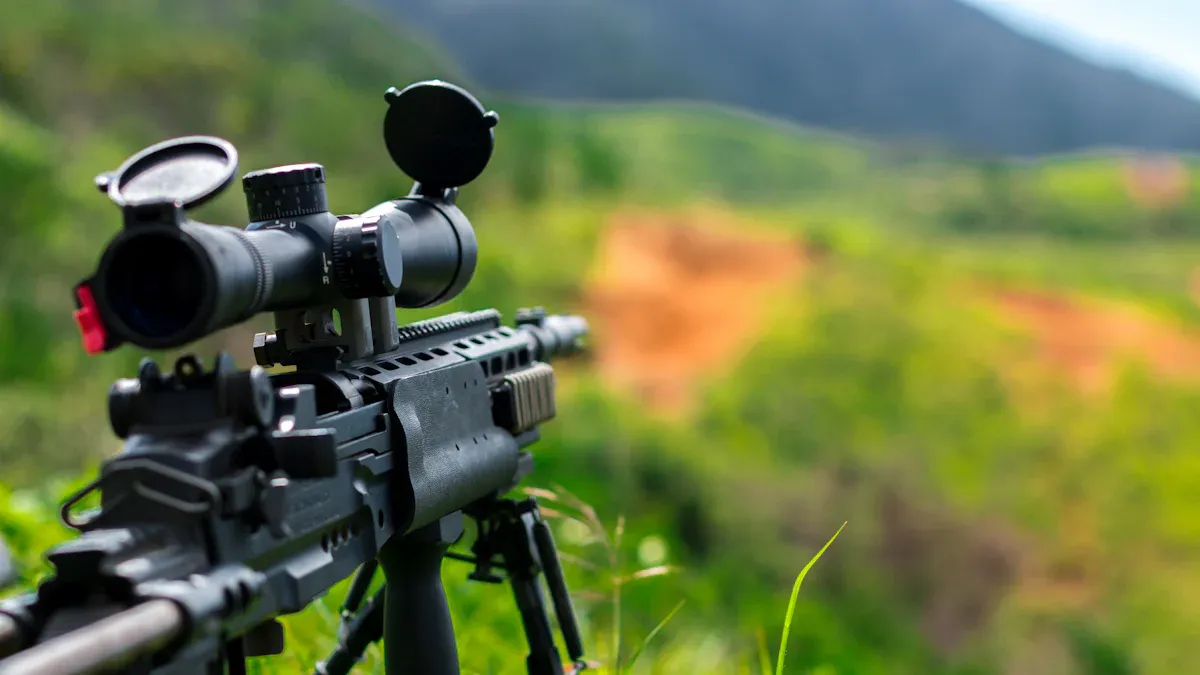
Selecting the right rifle bipod is essential for excelling in 3-gun competitions. A well-designed bipod provides stability, enabling shooters to manage recoil effectively. Top competitors often carry multiple bipods to adapt to various stages. This approach improves accuracy and ensures a stable shooting position, which can determine success in matches decided by just one or two hits.
Key Takeaways
- Pick a bipod that is strong and steady. Materials like aluminum or carbon fiber last longer and work well.
- Go for a lightweight bipod to carry it easily. A lighter bipod helps you move faster and feel less tired.
- Make sure the bipod can change height and fits your rifle. This helps you shoot comfortably on different surfaces.
Key Factors to Consider When Choosing a Rifle Bipod

Stability and Durability
A rifle bipod must provide a stable shooting platform, especially during rapid transitions in 3-gun matches. Stability ensures consistent accuracy, while durability guarantees long-term performance. Bipods made from materials like aluminum or steel are highly reliable. Experienced shooters often recommend models like the MDT Ckye-Pod for their robust build and ability to withstand harsh conditions. Durable materials also enhance stability, making them ideal for long-range shooting scenarios.
Weight and Portability
Weight plays a critical role in portability. Shooters need a lightweight bipod to move quickly between stages without compromising stability. Carbon fiber bipods are a popular choice due to their lightweight design and durability. The table below compares the weight and user preferences for different bipod types:
| Type of Bipod | Weight (ounces) | User Preference (%) |
|---|---|---|
| Carbon Fiber Bipods | < 14 | 67% |
| Aluminum Alloy Bipods | 18-22 | 31% |
| Hybrid Bipods (Carbon/Steel) | N/A | 56% |
Choosing a lightweight option can significantly reduce fatigue during competitions.
Adjustability and Height Range
Adjustability is essential for adapting to different shooting positions. A bipod with a wide height range allows shooters to maintain a comfortable and stable stance, whether prone or on uneven terrain. Look for models with quick-deploy legs and multiple locking positions to ensure seamless transitions during matches.
Attachment Types and Compatibility with Rifles
Not all bipods fit every rifle. Shooters should verify compatibility with their firearm’s mounting system. Common attachment types include Picatinny rails, M-LOK, and swivel studs. Selecting a bipod that matches the rifle’s configuration ensures secure and hassle-free installation.
Material and Build Quality
The material of a rifle bipod directly impacts its performance and longevity. Premium options made from aerospace-grade aluminum or carbon fiber offer excellent durability and weight reduction. Reviews frequently highlight carbon fiber bipods for their lightweight yet sturdy design. Aluminum models, on the other hand, provide a balance between weight and strength, making them a versatile choice for various shooting conditions.
Pro Tip: Hands-on testing is the best way to assess a bipod’s build quality. Durable materials not only enhance stability but also ensure reliability under stress.
Top Rifle Bipods for 3-Gun Matches

Harris S-BRM 6-9” Bipod – Features, Pros, and Cons
The Harris S-BRM 6-9” Bipod is a popular choice among precision shooters due to its durability and reliability. Its adjustable legs provide a height range of 6 to 9 inches, making it ideal for prone shooting. The bipod features a swivel mechanism that allows for easy leveling on uneven terrain. Users have praised its robust construction, which ensures long-term performance even in demanding conditions.
Pros:
- Lightweight and compact design.
- Swivel feature for enhanced versatility.
- Durable materials suitable for competitive use.
Cons:
- Higher price point compared to similar models.
- Limited height range may not suit all shooting positions.
One user noted that the LaRue Harris Combo version of this bipod feels exceptionally solid and includes modernized features that improve usability, despite its premium cost.
Atlas PSR BT46-LW17 Bipod – Features, Pros, and Cons
The Atlas PSR BT46-LW17 Bipod is a premium option designed for professional shooters. It offers a wide range of adjustability, with legs that can extend and lock at multiple angles. The bipod is constructed from aerospace-grade aluminum, ensuring a lightweight yet sturdy build. Its quick-detach Picatinny mount provides secure attachment and easy removal.
Pros:
- Exceptional build quality with durable materials.
- Multiple leg positions for versatile shooting angles.
- Quick-detach system for fast transitions.
Cons:
- Expensive compared to other bipods.
- Slightly heavier than carbon fiber alternatives.
This bipod is ideal for shooters who prioritize precision and adaptability during 3-gun matches.
Harris S-Series 9-13” Bipod – Features, Pros, and Cons
The Harris S-Series 9-13” Bipod is known for its ruggedness and functionality, particularly for heavier rifles like the M1A. It features adjustable legs and a rotating mechanism, allowing for smooth transitions on uneven surfaces. The lightweight design makes it a practical choice for competitive shooters.
Pros:
- Adjustable legs for a height range of 9 to 13 inches.
- Rotating mechanism for improved stability.
- Lightweight yet durable construction.
Cons:
- Some models may not match advertised features.
- Mixed reviews regarding product consistency.
Users have provided varied feedback. Bobby Forge praised its ruggedness and suitability for heavy rifles, while J Joshua Watson expressed disappointment over discrepancies in advertised features. Despite this, the bipod maintains a 67% positive rating, with many users satisfied with its performance.
How to Test and Use a Bipod Effectively in 3-Gun Matches
Testing Stability and Adjustability Before a Match
Testing a rifle bipod’s stability and adjustability is essential for optimal performance during a 3-gun match. Shooters should evaluate the bipod in various positions, such as prone and sitting, to ensure it provides consistent support. A table summarizing key features to test can guide this process:
| Feature | Description |
|---|---|
| 5-axis adjustment | Enhances stability and adaptability in different shooting environments. |
| Prone position | Demonstrated stability against recoil, with a wide stance providing extra support. |
| Sitting position | Allowed for adjustments to achieve a comfortable and stable shooting position, resulting in six hits out of six shots. |
| Leg extension | Easy to extend and adjust, contributing to overall stability during various shooting positions. |
Additionally, shooters should simulate match conditions by creating a test environment that mirrors competition settings. This approach ensures the bipod performs reliably under stress.
Practicing Transitions Between Positions
Efficient transitions between shooting positions can significantly impact match performance. Shooters should practice moving from standing to prone or kneeling while maintaining control of their rifle. Studies show that nearly half of successful transitions occur within 10 seconds, emphasizing the importance of speed and precision. Regular drills can help shooters refine their technique and reduce transition times.
Tips for Setting Up Your Bipod for Prone Shooting
Proper setup of a bipod for prone shooting enhances stability and accuracy. Shooters should extend the legs to achieve a comfortable height and ensure the rifle is level. Adjusting the cant and tilt features allows for better alignment on uneven terrain. A well-set bipod minimizes recoil impact, enabling faster follow-up shots.
Maintenance and Care for Long-Term Performance
Routine maintenance ensures a bipod remains reliable over time. Shooters should clean the bipod after each match to remove dirt and debris. Lubricating moving parts prevents wear and ensures smooth operation. Inspecting for loose screws or damage before every match can prevent unexpected failures during competition.
Selecting the right rifle bipod can significantly impact performance in 3-gun matches. Stability, weight, and adjustability remain the most critical factors to evaluate. Shooters should test their chosen bipod in realistic conditions to ensure it meets their needs. Practicing with the equipment enhances confidence and improves results during competitions.
FAQ
What is the ideal height range for a rifle bipod in 3-gun matches?
The ideal height range depends on the shooter’s preference and terrain. Most competitors prefer bipods adjustable between 6 to 13 inches for versatility.
How often should a rifle bipod be maintained?
Regular maintenance is crucial. Clean the bipod after every match, lubricate moving parts, and inspect for damage to ensure long-term reliability.
Can a single bipod work for all rifle types?
Not all bipods fit every rifle. Shooters should check compatibility with their firearm’s mounting system, such as Picatinny rails, M-LOK, or swivel studs.
Pro Tip: Always test a bipod with your rifle before a competition to avoid compatibility issues.
Post time: Apr-07-2025
